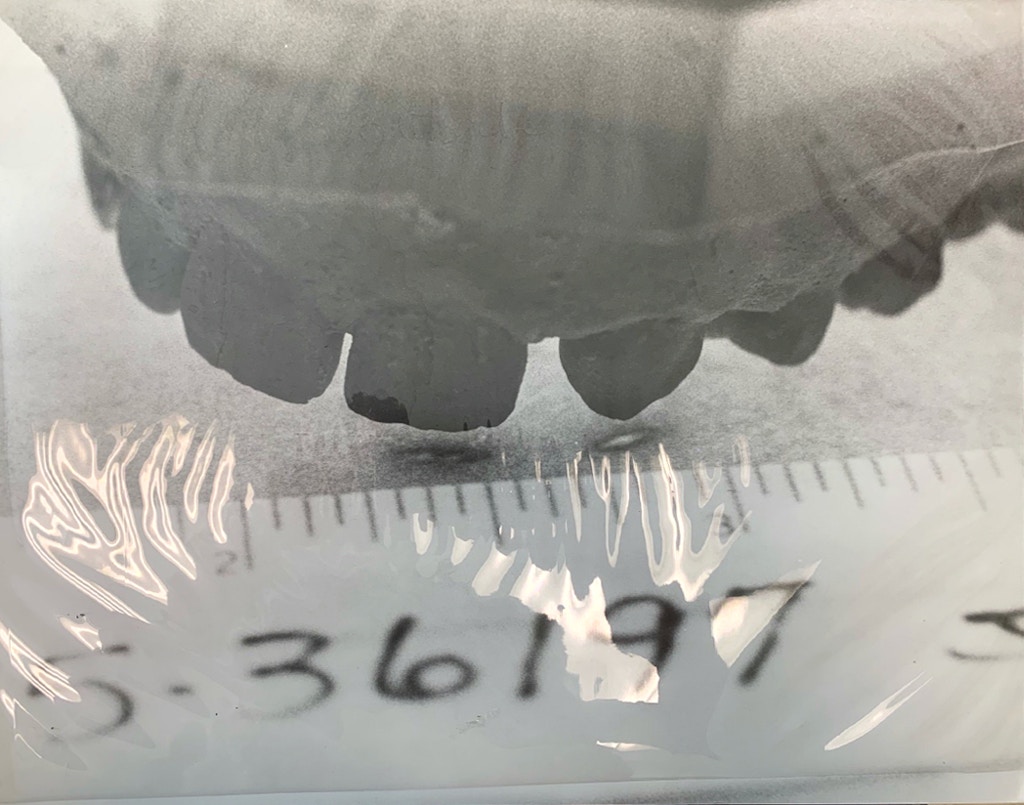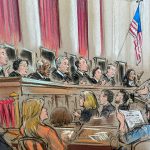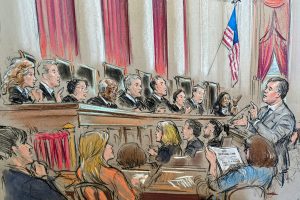
On a rainy morning in early February, Chad McCrory rose to speak at the headquarters of the Alabama Board of Pardons and Paroles in Montgomery. Wearing a dark suit, a paisley tie, and a white visitor sticker over his breast pocket, he unfolded a piece of yellow notebook paper and placed it on the podium. A small digital timer sat in front of him, set for two minutes. This was all the time he had to explain to the board why, nearly four decades after his mother was murdered, Chad wanted her supposed killer — his 64-year-old father, Charles — to come home.
“Julie Bonds McCrory was my mother,” Chad said. “She was taken from me from a very early age. I’m 40 years old now.” Chad had no memory of the murder or his father’s 1985 trial. The crime had traumatized the tight-knit community of Andalusia, where Chad still lives, turning neighbors against Charles McCrory as soon as he became a suspect. But as long as Chad could remember, his father had insisted he was innocent — and most of his family believed him.
“I was raised by my grandparents,” Chad continued. “My dad’s parents. They loved my mom like their own child.” Although they supported Chad’s relationship with his incarcerated father, “they also encouraged me to make my own decision on supporting him.” As he got older, Chad said, he tried to keep an open mind about family members who believed McCrory was guilty. He spent hours talking to his maternal uncle, Barry Bonds, who consistently opposed his father’s release. Yet Chad said he was grateful for their time together. “I learned a lot of things about my mom growing up.” He could never get her back. But he hoped to reunite with his father before he died behind bars.
Chad’s wife and other family members watched the proceeding with a mix of attentiveness and resignation. “They’ve pretty much made up their minds,” Charles McCrory’s younger sister, Laura Grissett, said before the hearing began. “It feels just like a waste of time.” Although the board chair, former Birmingham prosecutor Leigh Gwathney, smiled encouragingly as Chad spoke, they knew better than to feel hopeful. The hearing had begun with a tense exchange between Gwathney and McCrory’s lawyer, Mark Loudon-Brown of the Southern Center for Human Rights, who reiterated a point he’d emphasized in McCrory’s parole application: that prosecutors in Covington County — the same office that convicted his client — had made clear that they no longer considered McCrory a threat to public safety.
“In April of 2021, the district attorney made Mr. McCrory an offer to time served that would have allowed him to leave court that very day and go home unsupervised,” Loudon-Brown said during his own two-minute presentation. The offer, which McCrory rejected because it came with the requirement that he admit to killing his wife, was made on the eve of an evidentiary hearing that would debunk the single most important piece of evidence that sent McCrory to prison for life: a supposed bite mark found on his wife’s body.
Although a famed bite-mark analyst insisted at trial that the mark conclusively linked McCrory to the murder, that same expert has since recanted, saying he would never deliver such testimony today. In the years since McCrory was convicted, bite-mark analysis has been roundly discredited as junk science. Nevertheless, the judge who presided over the evidentiary hearing was unmoved. He ruled against McCrory, keeping him locked up. McCrory is the last known defendant still imprisoned for a conviction almost entirely based on the faulty forensic practice.
Regardless of his client’s innocence claim, Loudon-Brown said, the offer from prosecutors reflected a belief that McCrory had been “sufficiently punished, that his release would be consistent with the safety of the community … and that his exemplary prison record justifies his release.” Gwathney bristled at this characterization. “Did the district attorney make those statements regarding his reasoning?” she asked pointedly. Wasn’t it possible he had different reasons for offering such a deal? Loudon-Brown conceded there were likely a number of reasons. But the offer still showed a willingness to free McCrory — the very question now before the parole board.
Gwathney’s posture made clear how she intended to vote. Under her tenure, the number of applicants granted parole has dropped precipitously. In Alabama, parole proceedings are cursory and notoriously stacked against incarcerated people, who are not even allowed to attend their own hearings. Yet in some ways, McCrory was luckier than most. Unlike the man whose case was called before his that morning, he had family members present, a legal advocate, and even the support of a retired Department of Corrections employee, who felt strongly enough to appear before the board in person. Retired after 35 years, she described McCrory as “a very skilled, very talented, and very intelligent person. I had no fears of him whatsoever.”
Chad was still speaking when the timer went off. “This has been the 12th parole board we’ve attended,” he said, urging the board to consider the many certificates his father had earned behind bars. Chad tried to make a final point: The prosecutors who made the plea offer were part of his community too; people he did business with, went to church with. “And I feel like —”
The bailiff stepped forward. “Your time is up,” he said.
Charles and Julie McCrory with their son, Chad.
Credit: Courtesy of Larry Grissett
Rush to Judgment
In 2022, The Intercept published a deep-dive investigation into McCrory’s case, detailing his long-standing claim of innocence. But the evidence pointing to his wrongful conviction was not discussed at the parole hearing. Maintaining innocence is rarely a winning strategy in front of parole boards, which expect contrition from the incarcerated people who appear before them. It’s the court system, theoretically at least, that is supposed to consider whether evidence supports a claim of innocence. When a trial judge rejects such a claim, as the Covington County judge did in McCrory’s case, then it falls to appellate courts to determine whether that was the right call.
So far that has not helped McCrory either. The courts that have reviewed his conviction have willfully ignored the discredited forensic evidence at the heart of his case, dismissing the bite-mark expert’s recantation and going so far as to craft an entirely new narrative of the crime in order to keep McCrory in prison.
Julie McCrory’s body was found inside the couple’s house on the morning of May 31, 1985. She was lying prone, her head was bashed in, and she’d been repeatedly stabbed in the chest. Chad, then 3 years old, was found unharmed in his crib. The police quickly zeroed in on McCrory as their only suspect: He and Julie were separated, and McCrory had been having an affair with a former co-worker. At trial, the theory seemed to be that he’d savagely murdered Julie to be free from her.
The police investigation was cursory at best. Detectives searched McCrory’s home and car and found nothing to connect him to the bloody crime. Police also found personal items that prosecutors sought to introduce at trial despite their lack of relevance to the crime: a VHS tape and a collection of photos featuring Julie and her husband in kinky scenarios. “There is more than one scene in which the young lady is — what is considered in bondage,” a defense witness testified at a pretrial hearing. The state apparently hoped to show that “bondage sex” could lead to “stronger and stronger acts of violence,” as one prosecutor put it. Although the items were barred by the presiding judge, rumors swirled in the run-up to the trial, and many came to believe that the murder was linked to some kind of sex ring.
According to the state’s star witness, the puncture wounds on Julie’s arm were a perfect match to McCrory’s unique dentition.
Ultimately, the state latched onto a single piece of physical evidence as dispositive of McCrory’s guilt: two small indentations on the back of Julie’s right arm, which they concluded was a bite mark made by McCrory’s allegedly distinctive dentition.
The state rushed the case to trial in October 1985, but there was little else in the way of evidence. McCrory and his father had been the first to discover Julie’s body that morning; they’d gone to check on her after she failed to drop Chad off at his grandparents’ house. Police decided that McCrory was acting strangely when they arrived on the scene. Detective Billy Treadaway testified that McCrory asked him if Julie had been killed by a “lick on the back of her head,” which he found odd since her injuries had not yet been documented. Under cross-examination, Treadaway acknowledged that Julie was found with her head in a pool of blood but insisted, “You couldn’t see the lick on the back of the head. You could just see her head splattered open.”
The most important witness for the state was Dr. Richard Souviron, a forensic dentist who rose to fame after testifying during the trial of serial killer Ted Bundy. Even though Souviron had cautioned prosecutors early on against using the bite mark at McCrory’s trial absent other solid physical evidence, when he got on the stand, he was unequivocal, saying that the two puncture wounds on Julie’s arm were a perfect match to McCrory’s unique dentition — and only .5 percent of people in the world had dentition like McCrory’s.
The next day, the jury found McCrory guilty. He was sentenced to life in prison.
A Star Witness Recants
Bite-mark analysis depends on two assertions: that human dentition is unique and that skin is a suitable substrate to record that uniqueness. Neither is true; research has revealed that human dentition is not unique, and skin, as malleable as it is, is a poor medium for preserving an accurate record of injury. In recent years, the scientific community has repeatedly interrogated bite-mark analysis, deeming it a random and purely subjective practice. To date, more than two dozen people convicted on bite-mark evidence have been exonerated.
In 2020, Loudon-Brown and attorney Chris Fabricant of the Innocence Project filed a petition with the court in Andalusia where McCrory was tried, asserting his innocence and asking that his conviction be overturned. They had powerful new evidence: Souviron had recanted his trial testimony. “I no longer believe, as I did at the time of trial, that there is a valid scientific basis for concluding that the injury found on the skin of the victim … could be ‘matched’ or otherwise connected to a specific individual,” he wrote in an affidavit. “I therefore renounce that testimony.”
Circuit Judge Lex Short convened an evidentiary hearing the following spring. Two forensic odontologists, Adam Freeman and Cynthia Brzozowski, former true believers in bite-mark evidence, testified about the discipline’s demise and said there was no basis to conclude that the marks on Julie’s arm were made by teeth, let alone McCrory’s teeth.
More than two dozen people convicted on bite-mark evidence have been exonerated.
Covington County Chief Assistant District Attorney Grace Jeter did not call any experts to rebut Freeman and Brzozowski, but she dismissed Souviron’s recantation, suggesting that there was a difference between bite-mark analysis and “teeth-mark” analysis, and that Souviron had engaged in the latter. She told the judge that even without Souviron, the jurors could have taken the molds of McCrory’s teeth and photos of Julie’s injuries and made the comparison on their own.
Jurors aren’t “allowed to engage in their own junk science,” Loudon-Brown responded.
Short issued a brief ruling in February 2022, which parroted Jeter’s arguments and denied McCrory relief. The judge ignored Souviron’s recantation, found that Freeman and Brzozowski offered little more than a difference of opinion — what’s known as impeachment evidence — and agreed that jurors could have decided for themselves that the injury to Julie’s arm was inflicted by McCrory. Even without Souviron’s testimony, Short concluded, there was enough circumstantial evidence tying McCrory to the murder, such as his comment about the “lick” on Julie’s head, to uphold the jury’s verdict.
McCrory’s lawyers contested the ruling before the Alabama Court of Criminal Appeals. Souviron’s opinion wasn’t merely challenged by other dentists, they noted, but wholly recanted. The discredited bite-mark analysis was the only evidence tying McCrory to the murder; without it, there was nothing to sustain his conviction.
The lawyers argued that police had failed to consider evidence that pointed away from McCrory, including hairs found clutched in Julie’s hand. And while there was physical evidence from the crime scene that could have been tested for DNA, it was subsequently destroyed by the state. Today, all that remains in the evidence room at the courthouse is the dental mold of McCrory’s teeth.

A photo taken by Dr. Richard Souviron shows the injury on Julie McCrory’s arm alongside Charles McCrory’s dental mold.
Photo: Courtesy of the Southern Center for Human Rights
Willful Ignorance
In its reply to the appeals court, the state, now represented by the attorney general’s office, amplified Short’s conclusions. It ignored Souviron’s recantation (save for a single reference to it as “alleged”) and leaned into the argument that McCrory’s challenge to his conviction was nothing more than a dispute over differing expert opinions amid the “shifting science” of bite-mark analysis.
The state also relied on a creative recasting of the facts.
In her brief, Assistant Attorney General Kristi O. Wilkerson dismissed the allegation that the cops had failed to pursue evidence of an alternate suspect and spun circumstantial elements of the case, like the fact of McCrory’s affair, into an elaborate narrative that bore little resemblance to the testimony offered at trial. McCrory was “passionately in love” with the woman he’d had an affair with, desperate to sever ties with Julie, and turned to murder as the only way out. Julie’s death, she wrote, would solve all McCrory’s problems.
Wilkerson’s brief tried to make it appear that the case against McCrory was about everything but the alleged bite mark — a position that the trial prosecutor does not share. In an interview with Loudon-Brown after the 2021 evidentiary hearing, the prosecutor said the bite mark was “key” to the state’s case and “clearly” the basis of McCrory’s conviction.
“Her decision not to recuse jeopardized the partiality of the entire court.”
The state’s reframing of the issue apparently sat just fine with the Alabama Court of Criminal Appeals, which denied McCrory’s appeal in December. The opinion was mostly cribbed from the court’s denial of McCrory’s first appeal back in 1986 and quoted extensively from Short’s ruling. It, too, failed to acknowledge Souviron’s recantation and suggested that while there might be issues with bite-mark analysis, the same could not be said of “teeth-mark analysis.”
McCrory’s lawyers asked the court to reconsider its position. “This court erroneously split hairs regarding a pseudo-distinction between ‘bite marks’ and ‘teeth marks,’ wrongly concluding that Mr. McCrory’s petition is based on mere impeachment evidence that would not have changed the result of his trial,” they wrote. “An unrebutted and unimpeached recantation of critical expert testimony is not merely impeachment evidence — the evidence no longer exists.”
And there was a second problem: One of the appeals court judges, Elizabeth Kellum, had previously worked at the attorney general’s office and argued against McCrory’s 1986 appeal. “Judge Kellum signed the state’s brief in Mr. McCrory’s original appeal,” his lawyers wrote. “This creates an appearance of impropriety that, under the canons of judicial ethics, mandates recusal. Her decision not to recuse jeopardized the partiality of the entire court and violated Mr. McCrory’s constitutional rights.”
The court agreed to rehear the case, but instead of actually doing so, it merely removed Kellum’s name and reissued its previous opinion.
“When Judge Kellum was an assistant attorney general, she advocated for the state, against Mr. McCrory,” Loudon-Brown wrote in a statement to The Intercept. “Her involvement as a judge hearing Mr. McCrory’s case after she litigated against him cannot be squared with the constitutional requirement that judges be impartial and objective decision makers.”
Loudon-Brown said that McCrory’s team will again ask the court to reconsider his case. If it declines, they will appeal to the Alabama Supreme Court.
Who Speaks for the Dead?
Outside the building where McCrory’s parole hearing took place, signs directed visitors to one of two doors. There was the “Victim Waiting Room” and the “Offender Waiting Room.” People like Chad — the victim’s son, who also supported his father — were assigned to the latter category.
The hearing room was similarly divided. On the left side, relatives who opposed parole sat alongside lawyers for the state. Also present was a representative of the nonprofit Victims of Crime and Leniency, or VOCAL, which attends all parole hearings and opposes release in every homicide case.
At around 9:30 a.m., Barry Bonds, Chad’s uncle, stood to address the board. “I am here to protest Charles McCrory’s release,” he said. “It’s a very long story, and I can’t get it all in in the time that I have.” As Julie’s youngest brother, Bonds said, he once looked up to McCrory, who was an EMT and auxiliary police officer. “He got me involved in the Andalusia Rescue Squad.” But then he pivoted, invoking the rumors that had swirled around McCrory’s trial. “There was a lot of wife-swapping, a lot of sex stuff going on in the community,” he said, without elaborating.
“The one thing that has stuck in my mind for many years,” Bonds went on, was the statement McCrory made at the scene: “‘Did the blow to the back of her head kill her?’ Only someone that was there would ask that question.” If McCrory would simply confess to the crime, Bonds suggested, he might still be able to “spend eternity in heaven.”
“I am the voice of Julie. … I never had the opportunity to know her.”
The next speaker was VOCAL Director Janette Grantham. Although she said she’d been asked by Julie’s family not to oppose parole for McCrory, she took it upon herself to speak anyway. “I am the voice of Julie,” she said. “I never had the opportunity to know her. But I’m sure if she had the opportunity to be here today, she would tell you she did not want to die.” McCrory had been convicted and sentenced to life by a jury of 12 people, Grantham said, therefore he should remain in prison. This was what his victim deserved. “And she deserves to have her voice heard today.”
There were two prosecutors representing the state. Nayla Contreras, of the attorney general’s office, reminded the board that parole is “a privilege and not a right.” The fact that someone “is doing exceptionally well in prison” does not mean they should be released. McCrory was behind bars because of acts he chose to commit, she said, things he’s never owned up to. “Yes, 40 years is quite a long time to serve in prison. But I would submit to the board this morning that 40 years is a long time to be in a grave as well.”
Finally, there was Nikki Stephens, an assistant district attorney in Covington County. “I’m honored to speak today on behalf of and for Julie McCrory’s family,” she said. She quickly rehashed the evidence the state had presented ad nauseam: McCrory’s “salacious affair”; the brutality of the murder and extent of Julie’s injuries, which she described in graphic detail; and finally, McCrory’s incriminating statement. “And I quote: ‘Was it the lick to the back of the head that killed her?’”
Stephens disputed Loudon-Brown’s characterization of the state’s rationale for offering a plea deal in 2021. The real reason was that the case was at a “particular posture at that point,” she explained. “I don’t know that, if the conviction were overturned, we would be able to retry the case because of witness issues.” Many of the people involved in the investigation were deceased, Stephens explained. She made no mention of the state’s star witness, Souviron, who is very much alive.
After a few minutes of deliberation with the sole other board member in attendance (a former state trooper), Gwathney, the board chair, announced their decision. Parole was denied. “It is also the unanimous decision of the board that parole will be reconsidered in five years,” she said, prompting the bailiffs to see everyone out.
It had stopped raining when Chad and his group got outside. They gathered in a circle while Loudon-Brown explained his team’s next steps. They would keep fighting in the courts, he said. A few minutes later, the group was asked to clear the sidewalk leading to the parking lot. Shortly afterward, Bonds emerged from the building flanked by security staff, who escorted him to his car. The implication that Bonds needed protection from the rest of the family angered Grissett, McCrory’s sister. In the eyes of the state, Bonds’s opposition to freeing McCrory made him the only victim that counted. “Chad has never been treated as a victim,” she said.





